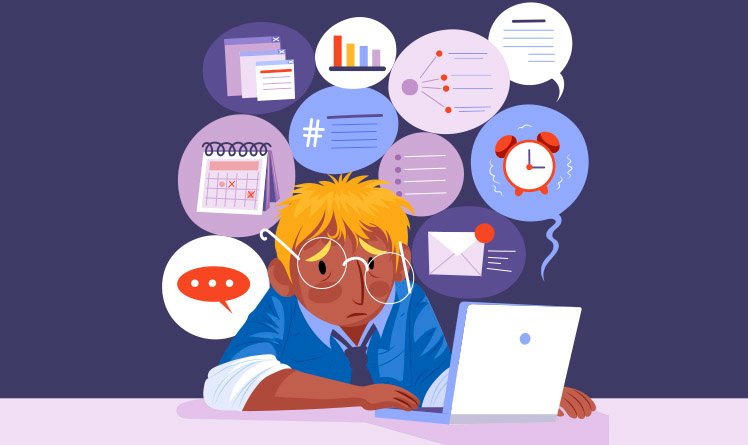Procrastination: Why It Happens and How You Can Beat It Once and For All

|
Getting your Trinity Audio player ready...
|
Who hasn't found themselves putting off an important task, even knowing the consequences? Procrastination is one of those universal habits: everyone knows what it is, but few understand why it occurs and, most importantly, how to stop falling into this trap.
Furthermore, many people confuse procrastination with laziness. But in practice, this behavior has deeper roots. It's linked to brain function, our emotions, and, most importantly, the limiting beliefs we hold. The good news is that there are clear and practical ways to overcome it—and that's what we'll discuss here.
What Real Procrastination Is (No Clichés)
Simply put: procrastination is the act of postponing an action, even knowing that it may have negative consequences.
“Procrastinating isn't laziness, it's an emotional escape mechanism when the brain associates the task with pain, fear, or discomfort.”
Behind procrastination, there is an unconscious attempt to avoid something that causes us anxiety, insecurity, or even the feeling of not being good enough.
Why is procrastination so common?
The neuroscience view
Our brains are designed to seek immediate pleasure and avoid pain. So when we look at a difficult task, it triggers the limbic system — part linked to emotions — and quickly seeks more pleasurable alternatives, such as using your cell phone, checking social media, or doing something “less urgent.”
Dopamine, the neurotransmitter associated with reward, enters the scene: quick, pleasurable tasks release dopamine instantly, while important projects require effort and only reward later. The result? We prefer immediate relief.
Hidden limiting beliefs
Internal phrases like:
- “I can’t.”
- “If I try, I will fail.”
- “It’s no use, it won’t work.”
These limiting beliefs—often created in childhood and reinforced throughout life—undermine confidence and make procrastination seem more comfortable than taking the risk of facing the challenge.
The impact of anxiety and perfectionism
On the other hand, many people procrastinate not because of a lack of willpower, but because of excessive pressure. Thus, the fear of not doing it "perfectly" paralyzes them. Anxiety creates catastrophic scenarios in their minds, and in the end, they choose to postpone.
“Perfectionism is one of the main causes of procrastination because it turns every task into a threat to our self-worth.”
Energy savings
Procrastination is also linked to the brain's energy-saving mechanism. The brain is, by nature, averse to excessive energy expenditure. After all, it consumes about 20% of all the body's energy, even though it represents only 2% of body weight. Therefore, it tends to avoid activities that require intense mental effort, especially when the benefit is not immediate.
In other words, when the brain perceives a task as uncomfortable, complex, or uncertain, it triggers procrastination as a form of "strategic delay." The unconscious reasoning is: “Why waste energy now if I can save it for something more urgent?”
This connects to three points:
- Survival principle: Our primitive brain prioritizes tasks related to immediate survival. Anything that doesn't pose a threat or immediate reward takes a back seat.
- Dissonance between effort and reward: If the reward is distant (like finishing a project in 3 months), the brain doesn't release dopamine now — and this makes you seek smaller activities that bring immediate pleasure.
- Cognitive cost: New or complex tasks require more mental resources (attention, working memory, self-control). Therefore, to save energy, the brain prefers automatic activities, even if irrelevant.
"Procrastination is also a brain strategy for conserving energy. When a task requires a lot of effort and the reward isn't immediate, the brain tends to postpone action."
The Invisible Consequences of Procrastination
At first, it may seem harmless: just putting things off a little longer. But accumulation creates a dangerous cycle:
- Anxiety increases as the task remains there.
- Self-esteem plummets because we feel like we “can’t handle it.”
- THE blame appears, further reinforcing the pattern of self-sabotage.
- Relationships and work suffer as deadlines are not met and promises are not kept.
In short: the more we procrastinate, the harder it is to act.
How to Stop Procrastinating: Practical Solutions
The good news is that procrastination isn't destiny, it's habit—and habits can be changed. Here's how:
Mindfulness to break the autopilot
Before starting any task, stop for 3 minutes and practice mindful breathing. This short exercise can be done anywhere—at your desk, on the couch, or even on public transportation.
Step by step:
- Sit comfortably, with your spine straight but relaxed.
- Close your eyes or keep your gaze softly on a fixed point.
- Bring your attention to your breathing: feel the air moving in and out of your nostrils, or the rising and falling of your abdomen.
- When your mind wanders (and it will!), simply acknowledge the thought and gently return to your breath.
- Stay like this for three minutes.
This simple exercise calms the nervous system, reduces anxiety, and creates a space between stimulus and response. Above all, it's in this space that you regain the power to choose to act—instead of giving in to the urge to procrastinate.
“Practicing mindfulness for three minutes before beginning a task helps silence distractions, reduce anxiety, and increase immediate focus.”
Positive Psychology to change focus
One of the greatest enemies of procrastinators is guilt. Thus, every time we put off a task, our mind creates a cycle of self-criticism: "I can't do it," "I'm lazy," "I'll never get it done." This inner voice sabotages motivation and further reinforces procrastination.
This is where the Positive Psychology: Instead of wasting energy criticizing yourself, you learn to shift your focus to what strengthens you.
Exercise 1 – Practical Self-Compassion:
- Imagine that a dear friend was going through the same problem as you.
- What would you say to support him?
- Now, say these same sentences to yourself.
This exercise breaks the cycle of guilt and restores the motivation to act.
Exercise 2 – Directed Gratitude:
- Before you start a task, write down three things you are grateful for that day.
- Then, write down how completing this task can further increase your gratitude list in the future (e.g., finishing a report = more recognition at work).
This simple gesture reorients the brain to perceive gains instead of focusing on the difficulty.
“Positive Psychology teaches that replacing blame with self-compassion and cultivating gratitude before action are powerful strategies for overcoming procrastination.”
NLP to reprogram mental patterns
Neuro-Linguistic Programming (NLP) is one of the most effective tools for breaking procrastination patterns because it directly affects how you mentally represent a task. After all, the problem often lies not in the task itself, but in the negative image or feeling your brain has created around it.
Practical exercise – Swish technique:
- Identify the limiting scene: Close your eyes and visualize yourself at the moment you usually procrastinate (for example, staring at a blank computer screen).
- Create the positive image: Now, imagine yourself completing the task with confidence, feeling relieved and satisfied. See yourself smiling, relaxed, and accomplished.
- Decrease the negative scene: reduce the size, color, and brightness of the negative image until it is small and weak.
- Amplify the positive scene: increase the brightness, bring the positive image closer, make it colorful and vivid, until it occupies all the mental space.
- Quickly exchange: Do the "swish"—push the negative scene away and bring the positive one closer in one quick mental movement. Repeat 6 or 7 times.
With repetition, your brain begins to associate the task with a positive state, reducing the emotional burden that fueled procrastination.
Extra exercise – Re-signification of beliefs:
- Identify a belief that blocks your action (“I’m not good enough,” “it’s going to go wrong”).
- Ask yourself: Is this belief 100% true?
- Replace it with a more empowering statement: “I am learning, and each step makes me stronger.”
“NLP teaches that by changing the images and beliefs we have about a task, we also change our willingness to act.”
Micro-habits: applied neuroscience
Procrastination often stems from the feeling that a task is too overwhelming. Thus, the brain interprets this challenge as a threat to balance and activates the instinct to conserve energy. This is where microhabits come in as a smart solution, breaking down large goals into small daily actions that seem too simple to postpone.
THE Neuroscience explains: when you complete a small action, your brain releases dopamine—the neurotransmitter that drives motivation. This feeling of victory creates a positive cycle, making it easier to take the next step.
Practical exercise – Break the task into microsteps:
- Choose a task you've been putting off.
- Ask: What is the smallest possible step I can take now?
- If you need to write a report: start by opening the file and typing the title.
- If you need to tidy up the house: just organize your desk.
- If you need to study: read just one page of the book.
- Do this step immediately, and if you feel energized, move on to the next one.
Extra Exercise – 5 Minute Rule:
- Tell yourself, “I’ll do this task for just 5 minutes.”
- Most of the time, once you start, you feel like you want to keep going. If you don't, that's okay: you've already broken through the initial barrier.
These small victories reprogram the brain to associate action with pleasure, not pain.
“Micro habits work because they train the brain to seek small, consistent rewards, creating motivation to move forward without excessive effort.”
Traps that keep procrastination alive
- Waiting for the perfect time: will never exist.
- Consuming too much information: reading, watching, or listening too much before acting only fuels paralysis.
- Constant comparison: looking at others and feeling “lesser” only reinforces the feeling of incapacity.
“The secret is not to wait for motivation to appear, but to create movement first. Motivation comes after action.”
Conclusion
Procrastination is common because it's rooted in how our brains work, our emotions, and the beliefs we hold. But that doesn't mean you're doomed to live in this cycle.
With awareness, small mindfulness practices, NLP techniques, positive psychology tools, and neuroscience strategies, you can break out of paralysis and regain your confidence.
And remember: transformation begins with the first step, however small. It's in movement that change happens.
FAQ – Questions and Answers about Procrastination
1. Why do we procrastinate even though we know what we have to do?
Because the brain associates the task with discomfort or fear, preferring quick and easy rewards.
2. How to differentiate procrastination from healthy rest?
Rest is planned and brings recovery; procrastination is escape and generates guilt.
3. Is there a quick technique to stop procrastinating immediately?
Yes. 3 minutes of mindful breathing can break the cycle and help you get started.
4. Is perfectionism directly related to procrastination?
Yes. The more we demand perfection from ourselves, the more we postpone action for fear of making mistakes.
5. Can procrastination be overcome definitively?
It can be significantly reduced. The key is to practice new habits and consistently reprogram your mind.
Image: Freepik

Marcel Castilho is an expert in neuromarketing, neuroscience, mindfulness and positive psychology. In addition to being an advertiser, he also has a Master's degree in NLP – Neurolinguistic Programming. As the owner and founder of the communications agency VeroCom and also of the digital agency Vero Contents, he has been studying human behavior for over 30 years.

